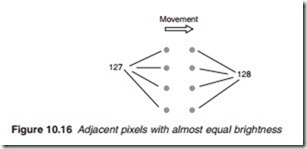False contours
The basic plasma technology described so far would produce an accept- able moving pictures but its quality leaves a lot to be desired as many of those who purchased early plasma television discovered to their dismay. The basic PDP suffers from two major shortcomings: dynamic false contours and black-level luminance.
False contours are a serious impairment of picture quality that appears on a moving picture. This artefact is the result of the SF coding techni- ques used to control the brightness of the pixel cells. As described earlier, TV picture frames are broken up into a number of SFs, conventionally, 8 binary-weighted SFs are used. Consider an image in which the brightness of two adjacent column of pixels is 127 and 128 respectively (Figure 10.16). The set of pixels on the right reach their brightness level of 127 by being selected and primed to discharge for the first seven of the 8 SFs while the second set to the left fires for the 8th SF only. For a still image there are no problems and the picture information would be re-produced without arte- facts. However, if there is movement from left to right, then what is known as false contours may be observed depending on the direction and speed of the movement. Figure 10.17 shows a schematic time chart representing two such adjacent pixels. The left pixel has a level of 127 moving towards a second to its right that has level of 128. Because the human eye follows the motion of an image, the movement of the pixel causes the visual sen- sation to be integrated along the arrow shown in the figure. The seven SFs of the pixel on the left and the 8th SF of the second pixel are added up by the eye resulting in a brightness intensity of 127 + 128 = 255 with a bound- ary of 127 on the left and 128 on the right. The effect for the human eye is a bright spot and in the case of few such pixel combination, a line contour. This artefact is most pronounced when an image of middle and almost uniform intensity such as a Caucasian skin or blue sky moves across the screen resulting in the smudging illustrated in Figure 10.18.
Several techniques have been developed by PDP manufacturers to min- imise the effect of false contour, namely time compression, SF splitting and non-binary weighting of SFs.
Time compression
The time-compression technique as the name suggests, reduces the light emission period of the SFs by introducing a time interval between one set of SFs and the next and consequently squeezing the SFs as shown in Figure 10.19. The time interval reduces the possibility of the eye adding up
the intensities of consecutive SFs. In this way, the area that may suffer false contours can be greatly reduced by a factor depending on the compression ratio.


